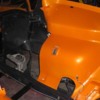I'm planning on pulling the engine and transaxle out of my white Pantera and
would like to smooth out and repaint the engine bay. I did this on my red
Pantera. In that case, the spot weld dimples were filled with body filler.
I've not had any problems with that car but it has maybe 7000 miles since
the engine compartment was painted. I discussed the issue with a fellow
Pantera owner (MidEngineMike) who is a professional auto body man. He
chose not to fill his spot welds but I prefer the smoother look. Those of you
that have filled them, what did you do and has it stood the test of time?
What would you do differently? I will be welding on brackets for chassis
reinforcement, hiding the air conditioner lines and relocating the pressure
tank at the same time. It will get a healthy stroker motor, too.
Thanks,
Dan Jones
Original Post






